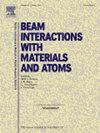The use of second foil stripping in tandem accelerators
IF 1.4
3区 物理与天体物理
Q3 INSTRUMENTS & INSTRUMENTATION
Nuclear Instruments & Methods in Physics Research Section B-beam Interactions With Materials and Atoms
Pub Date : 2024-09-25
DOI:10.1016/j.nimb.2024.165532
引用次数: 0
Abstract
The 10 MV FN Tandem at the University of Notre Dame’s Nuclear Science Laboratory has the option for a second foil stripper halfway down its high energy column. With its utilization, users are able to produce beams with higher energies and/or transmission than single foil stripping alone would be capable of achieving. A discussion of the Schiwietz–Grande, Nikolaev–Dmitriev, and Baudinet-Robinet semi-empirical models used to determine the resulting charge state abundances, as well as how they compare to measured charge state distributions is presented. The advantages of a second foil stripper are discussed alongside measurements of the charge state abundances produced. The potential for more interfering beam species of similar magnetic rigidity is also discussed. It was found that for most of the beams tested, second foil stripping allowed higher energies with higher yields than the single terminal foil stripping alone could achieve which can enhance the capabilities of other laboratories using similar accelerator systems.
串联加速器中第二箔片剥离的使用
圣母大学核科学实验室的 10 MV FN Tandem 可以在高能柱的中段选择安装第二个箔剥离器。利用它,用户能够产生比单箔剥离更高能量和/或传输率的光束。本文讨论了用于确定所产生的电荷状态丰度的 Schiwietz-Grande、Nikolaev-Dmitriev 和 Baudinet-Robinet 半经验模型,以及它们与测量电荷状态分布的比较。在对产生的电荷态丰度进行测量的同时,还讨论了第二箔剥离器的优势。此外,还讨论了更多具有类似磁刚度的干扰光束种类的可能性。研究发现,对于大多数测试的光束来说,第二箔剥离法比单端箔剥离法能获得更高的能量和更高的产率,这可以提高其他使用类似加速器系统的实验室的能力。
本文章由计算机程序翻译,如有差异,请以英文原文为准。
求助全文
约1分钟内获得全文
求助全文
来源期刊
CiteScore
2.80
自引率
7.70%
发文量
231
审稿时长
1.9 months
期刊介绍:
Section B of Nuclear Instruments and Methods in Physics Research covers all aspects of the interaction of energetic beams with atoms, molecules and aggregate forms of matter. This includes ion beam analysis and ion beam modification of materials as well as basic data of importance for these studies. Topics of general interest include: atomic collisions in solids, particle channelling, all aspects of collision cascades, the modification of materials by energetic beams, ion implantation, irradiation - induced changes in materials, the physics and chemistry of beam interactions and the analysis of materials by all forms of energetic radiation. Modification by ion, laser and electron beams for the study of electronic materials, metals, ceramics, insulators, polymers and other important and new materials systems are included. Related studies, such as the application of ion beam analysis to biological, archaeological and geological samples as well as applications to solve problems in planetary science are also welcome. Energetic beams of interest include atomic and molecular ions, neutrons, positrons and muons, plasmas directed at surfaces, electron and photon beams, including laser treated surfaces and studies of solids by photon radiation from rotating anodes, synchrotrons, etc. In addition, the interaction between various forms of radiation and radiation-induced deposition processes are relevant.

 求助内容:
求助内容: 应助结果提醒方式:
应助结果提醒方式:


